Hats in Art

A selection of major artworks including hats.
-
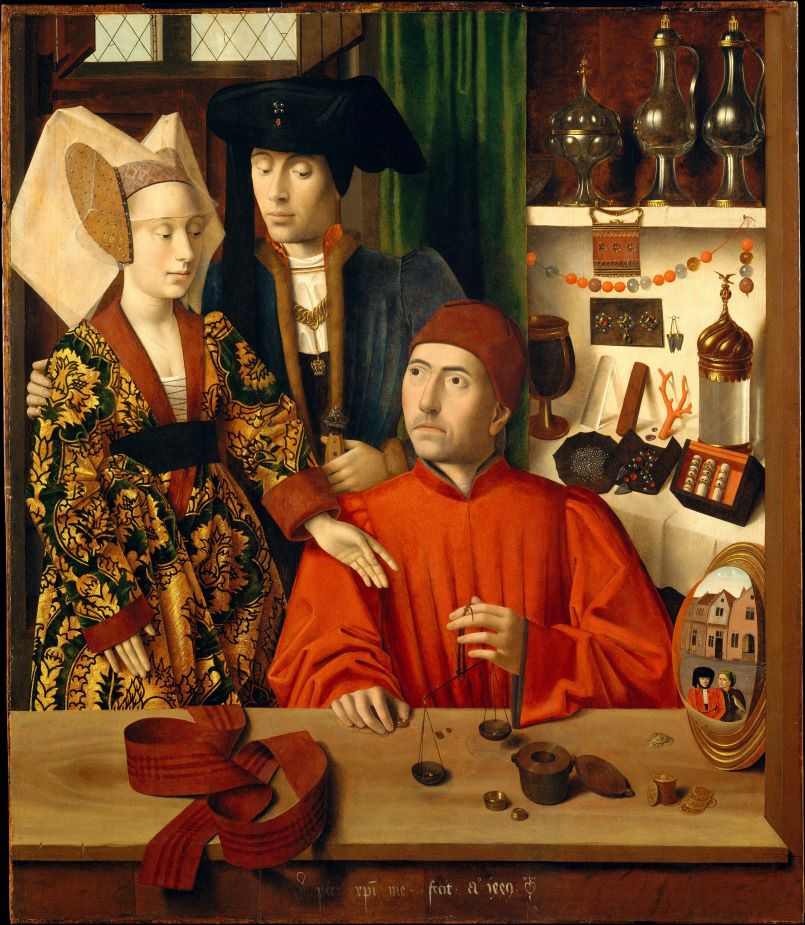
A Goldsmith in his Shop
Read More: Hat GlossaryPetrus Christus | 1449 | Oil on oak panel | The Metropolitan Museum of Art, New York
Christus was a leading Flemish artist of the Northern Renaissance. He ascribed to the tradition of illusionism, a style which sought to depict subjects and space realistically while also seemingly "sharing" that space with the viewer.
Here, a couple are depicted shopping for a wedding ring. The hats they wear were typical for the time period across Northern Europe, England, and France. The butterfly headdress worn by the woman is also referred to as a hennin or reticulated headdress.
-

Lady with an Ermine
View the Juliet Costume HatLeonardo da Vinci | 1489-91 | Oil on wood | Czartoryski Museum, Krakow
Da Vinci was one of the foremost artists and inventors of the Italian Renaissance. The painting shown here is of Cecilia Gallerani, lover to the Duke of Milan.
Cecilia is depicted wearing her hair in the more typical style of Southern Europe, mainly Spain and Italy. This style consisted of center-parted hair drawn into a long coil or coazzone (sometimes wrapped in cloth), a fine silk or linen hairnet (usually embroidered) placed at the back of head, and a headband or lenza placed across the forehead.
-
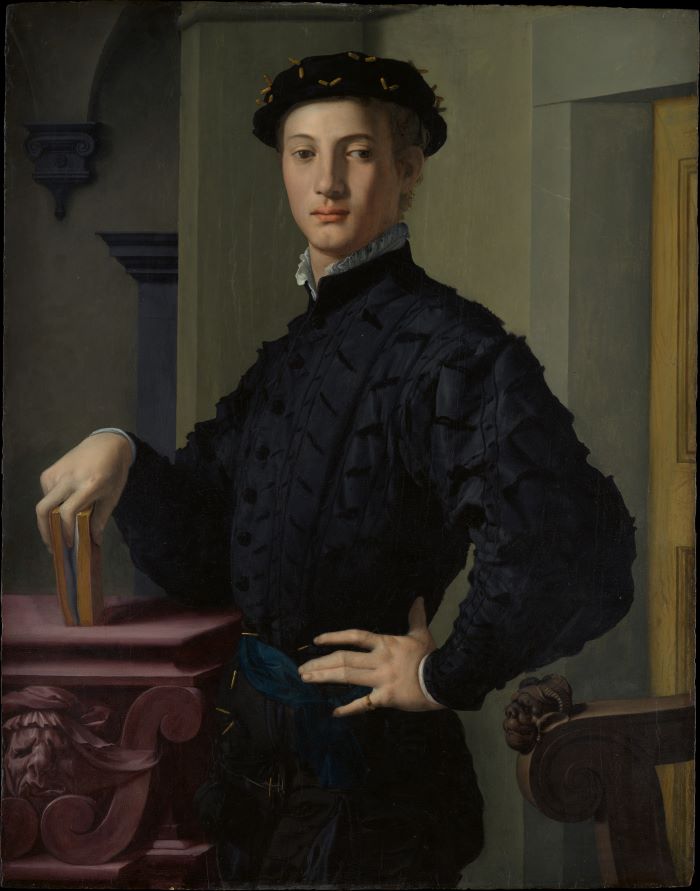
Portrait of a Young Man
View our Selection of BeretsAgnolo di Cosimo di Mariano Bronzino | 1530s | Oil on wood | The Metropolitan Museum of Art, New York
Bronzino was a Florentine painter and poet renowned for his mannerist style and elegant portraits during the high Italian Renaissance. Although the subject of this work remains unknown, he is thought to have belonged to Bronzino’s close group of literary friends and is pictured holding a volume of poetry.
The hat the young man is wearing is best described as a soft beret, probably made of velvet, embellished with beads or stones.
-
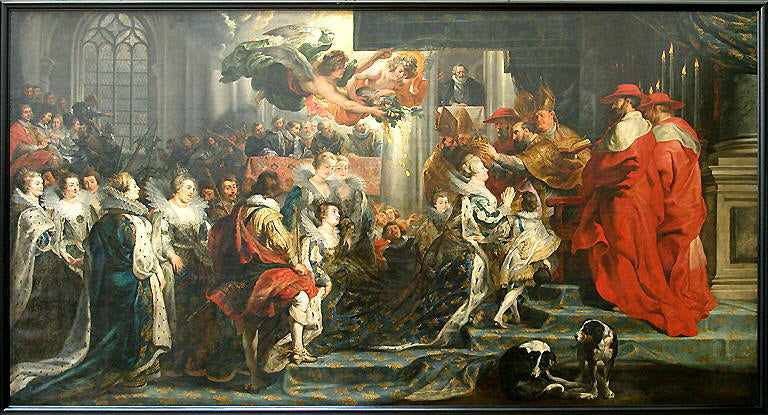
The Coronation of the Queen at the Abbey of Saint-Denis, May 13, 1610
Peter Paul Rubens | 1600-1625 | Oil on canvas | Le Louvre, Paris
For all of human existence, headwear has represented power and status. Marie de' Medici (pictured), in order to increase her power, demanded that King Henry IV of France allow her a separate coronation.
We are impressed by the profound significance this moment holds - a crown is placed on a head and the whole political world changes. King Henry IV was assassinated the very next day (May 14th, 1610); Marie ruled as regent until 1617.
-
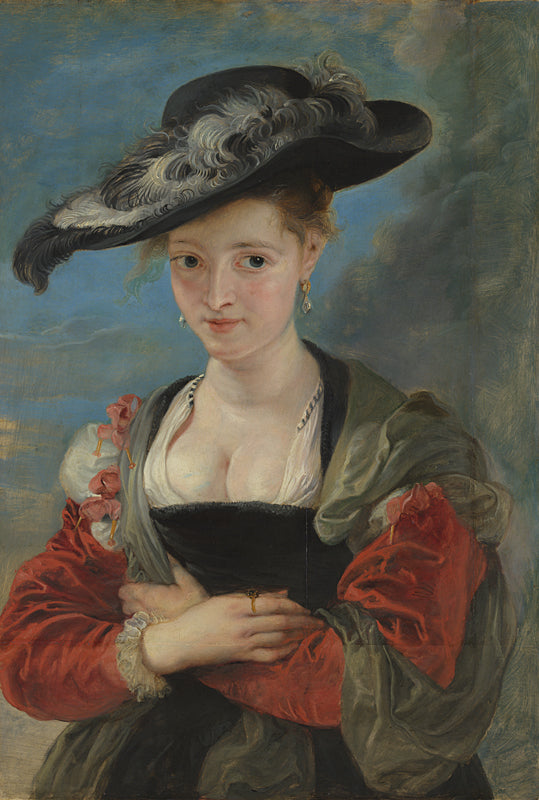
Le Chapeau de Paille / Portrait of Susanna Lunden
View Women's Straw HatsPeter Paul Rubens | 1626 | Oil on oak | The National Gallery, London
Rubens is often called "Prince of Baroque painters." In his style he successfully united the features of Northern (Flemish) Renaissance art with those of Italy. His influence on the painters of his century was enormous, as it was on sculpture and architecture.This is generally believed to be the portrait of Susanna Lunden, to whom Rubens was related to via marriage. She is pictured wearing a wide-brimmed dress hat adorned with feathers.
-

Self-Portrait at the Age of 34
Rembrandt Harmenszoon van Rijn | 1640 | Oil on canvas | The National Gallery, London
Despite being one of Rembrandt’s most famous self-portraits, it is, above all else, a statement on his place in history and a work of illusion. Although Rembrandt was Dutch and lived in the 17th century, he depicts himself in the dress of a wealthy gentleman in the 16th century. By doing so he was claiming a higher social status than that typically allotted to artists at the time, and on par with his wealthy clientele.
He is dressed in fine velvet and fur. His hat consists of a fine velvet beret laced with jewels. -
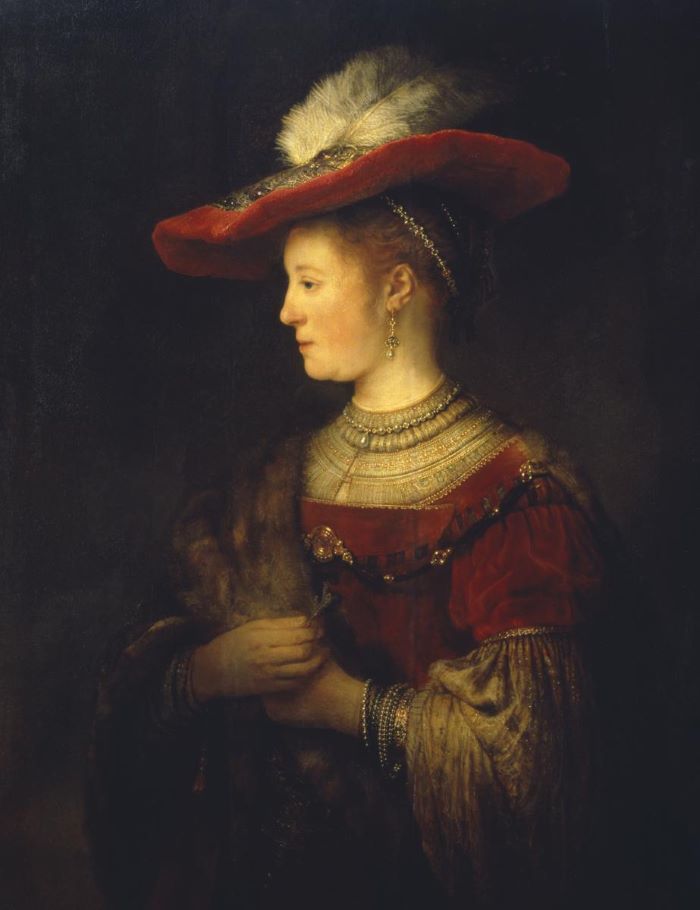
Saskia in a Red Hat
Rembrandt Harmenszoon van Rijn | 1642 | Oil on canvas | Gemäldegalerie Alte Meister, Kassel
Rembrandt depicts his beloved wife, Saskia, here. Although Rembrandt started this painting soon after their short marriage in 1634, he did not complete it until after her death in 1642. Of all the other paintings and sketches he made of Saskia, this is the only one showing her in profile view.
She is seen lavishly dressed in red velvet and gold, with a large red velvet hat encrusted with jewels and adorned with feathers.
-

Madame Bergeret
François Boucher | 1766 | Oil on canvas | National Gallery of Art, Washington DC
Boucher was a French painter famous for his work in the Rococo style, known for its idyllic, pastoral scenes and pastel palette. The subject is widely believed to be the first Madame Bergeret, Marguerite Josèphe Richard.
Madame Bergeret is seen holding a bergère style hat (French for "shepherdess"). This popular style of the time is also known as milkmaid or skimmer styles.
-

Portrait of Mrs. Siddons
Thomas Gainsborough | 1785 | Oil on canvas | The National Gallery, London
Thomas Gainsborough was an English painter and one of the founders of the Royal Academy. He was sought after for his portraits of fashionable and wealthy - often royal - subjects. As such, he had much influence over feminine fashion.
Mrs. Siddons is pictured wearing the famed “Gainsborough” hat with a low crown, wide brim turned up at one side, trimmed with plumes and taffeta or velvet ribbon, and designed to cover elaborate headdresses.
-
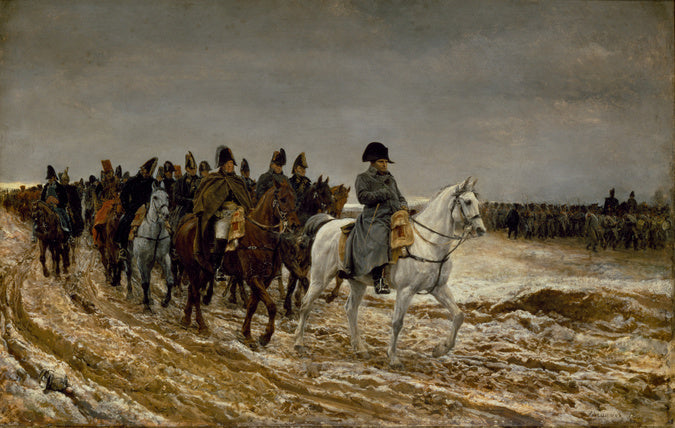
Campaign of France, 1814
View our Bicorns & TricornsJean Louis Ernest Meissonier | 1864 | Oil on wood | Musée d'Orsay, Paris
Meissonier, a French artist and dedicated nationalist, is most well-known for his military and warfare paintings as well his penchant for Napoleonic imagery.
Here, he depicts Napoleon and his staff returning from Soissons after the battle of Laon (this is not the retreat from Moscow as is often assumed). The "cocked hats" or bicorns pictured here, along with tricorns (worn both in military and civilian life), preceded top hats as the felt hat of choice for men of means.
-

Garden at Sainte-Adresse
View our Panama Straw HatsClaude Monet | 1867 | Oil on canvas | The Metropolitan Museum of Art, New York
This 1867 work by Monet is the earliest European art work (that we are aware of), depicting a Panama straw hat. Although a misnomer, ("Panama'' hats actually hail from Ecuador - read our Iconic Hats Blog for more) Panama straw hats became important trade items in the mid-19th century and, quickly thereafter, a must-have fashion in Europe and the Eastern USA.
Monet's seated gentleman appears to be wearing a Gambler style Panama hat, which remains fashionable today.
-

Arrangement in Grey and Black No. 1 / Portrait of the Artist's Mother
James Abbott McNeill Whistler | 1871 | Oil on canvas | Musée d'Orsay, Paris
American-born Whistler trained and worked in Paris and later London for most of his career. This 1871 oil painting is his most recognized work and one of the most famous paintings in the world by an American artist. It is now considered an icon of motherhood.
Here, Mrs. Whistler is pictured in profile against an austere and angular backdrop. She is pictured wearing an everyday white lappet cap or bonnet typical of the period.
-

Woman Reading
View our Selection of VisorsEastman Johnson | 1874 | Oil on board | San Diego Museum of Art
This work by American genre painter Eastman Johnson caught our founder’s attention. The painting was done circa 1874, pre-dating the introduction of the sun visor by a couple decades. The hat, however, is functioning almost exclusively as a sun visor - note the shadow on the woman's face. It seems the subject has changed the hat on her head from its intended position so that it serves as an aid to her reading. A perfect example of form following function in headwear.
-
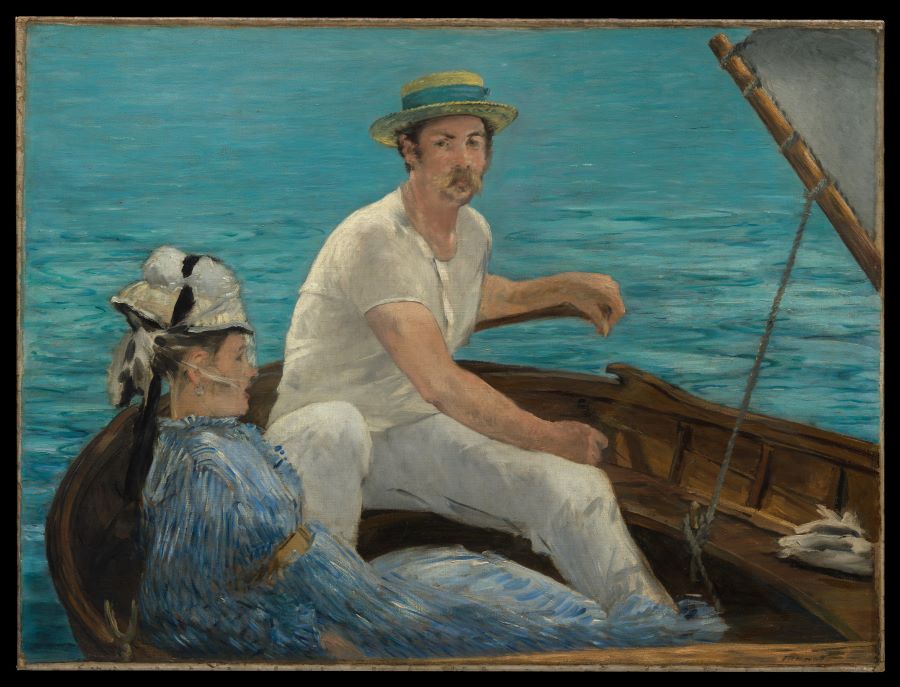
Boating
View Skimmer HatsÉdouard Manet | 1874 | Oil on canvas | The Metropolitan Museum of Art, New York
Together with Monet, Renoir, Degas, and others, Manet was at the forefront of the modernist Impressionist movement - characterized by its bright colors, broken brushstrokes, and emphasis on light.
In the late 19th and early 20th centuries, the men's straw skimmer (aka boater) became synonymous with summer leisure. Manet, as well as other artists of the time, use the skimmer as a symbol of the good life and the emergence of "leisure" as a right and privilege for all.
-

The Monet Family in Their Garden at Argenteuil
Édouard Manet | 1874 | Oil on canvas | The Metropolitan Museum of Art, New York
The summer of 1874 saw Impressionist masters Manet and Monet vacationing right across the Seine from each other. Their penchant for painting en plein air (French for “in open air” or “outdoors”) is evident in this happy domestic scene.
Monet is pictured tending to the garden while his wife and son rest nearby. Monet appears to wear a felt fedora while his wife is seen wearing a decorative bonnet. Their young son, Jean, is pictured wearing a straw skimmer.
-

Dance at Le Moulin de la Galette
Pierre-Auguste Renoir | 1876 | Oil on canvas | Musée d'Orsay, Paris
This painting of an outdoor dancehall during France’s Belle Époque is one of Impressionism's most well-known works and Renoir’s most important. Although many of his friends are positioned within, Renoir sought most to convey the lively and bustling atmosphere of the dancehall scene.
Again, leisurely straw boater hats - in addition to more traditional felt bowler and top hats - can be seen on most gentlemen's heads. Women are shown wearing bonnets or straw hats.
-
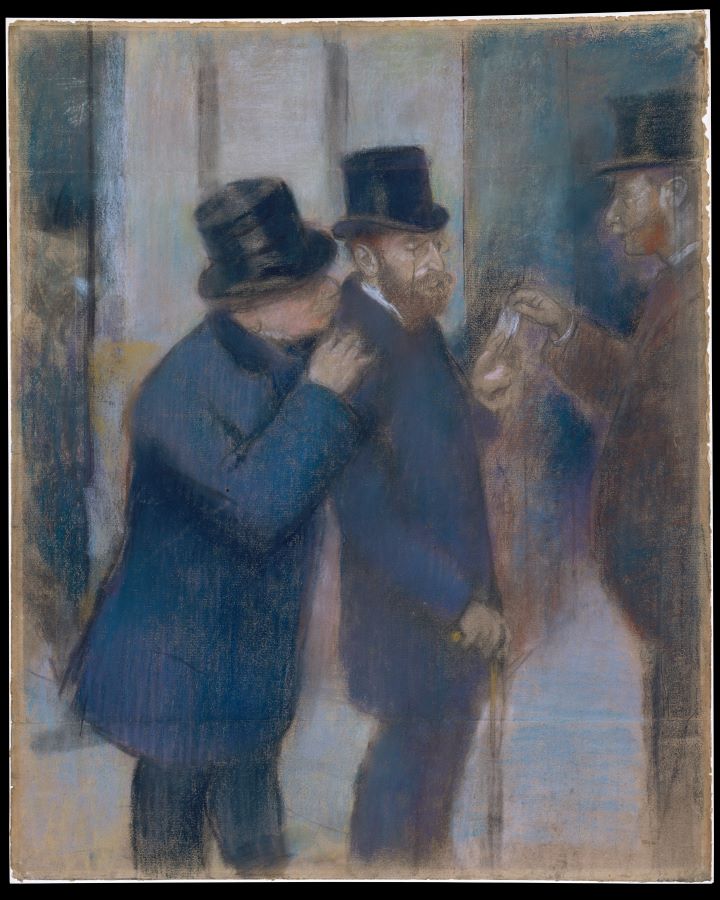
Portraits at the Stock Exchange
View our Selection of Top HatsEdgar Degas | 1878-79 | Pastel on paper, pieced, and laid down on canvas | The Metropolitan Museum of Art, New York
Degas, unlike his Impressionist contemporaries, favored indoor scenes illuminated by artificial light rather than plein-air scenes. This scene depicts three gentleman at the stock exchange in full dress, including felt top hats.
By the early 1800s, the top hat had supplanted the cocked hat or bi/tricorn. In 1890 the St. James Gazette wrote, "When we are told, 'He's a fellow who wears a top hat and a frock coat,' we know sufficiently well what sort of fellow he is."
-

Two Sisters (On the Terrace)
View our Selection of Women's HatsPierre-Auguste Renoir | 1881 | Oil on canvas | Art Institute of Chicago, Chicago
Renoir was renowned for favoring joyous scenes of modern life. Here he paints two lovely young women against the bucolic background of Chatou and the Seine on a bright spring day. Despite its title, the two girls are not actually related. The identity of the younger remains unknown, however, the elder is believed to have been Jeanne Darlot who later became an actress.
The girls are depicted wearing what seem to be felt or fabric hats, brims upturned at the front, and adorned with flowers.
-

On the Lake in the Bois de Boulogne
Berthe Morisot | 1884 | Oil on canvas | Private Collection
Morisot - one of only four female members of the Impressionist circle - was the only woman invited to exhibit with the Société Anonyme des Artistes-Peintres, Sculpteurs, Graveurs in 1874 which later came to be referred to as the first Impressionist exhibition. Despite achieving critical recognition during her lifetime, most critics would focus on the “feminine” qualities of her work such as “intuitiveness” and “delicacy.”
Here she depicts a woman and a girl floating along the Seine. Both are wearing what seem to be straw hats with adornments.
-

Self-Portrait with a Straw Hat
Vincent van Gogh | 1887 | Oil on canvas | The Metropolitan Museum of Art, New York
Van Gogh, a Dutchman, was heavily influenced by the largely French Impressionist and Neo-Impressionist techniques of broken brushstrokes and pointillism, respectively. Short on funds, the primarily self-taught van Gogh often resorted to self-portraits: "I purposely bought a good enough mirror to work from myself, for want of a model."
He painted at least twenty-four self-portraits in Paris between 1886-1888, including seven in which he wore a straw hat. The hat pictured here is most likely a straw fedora hat style.
-
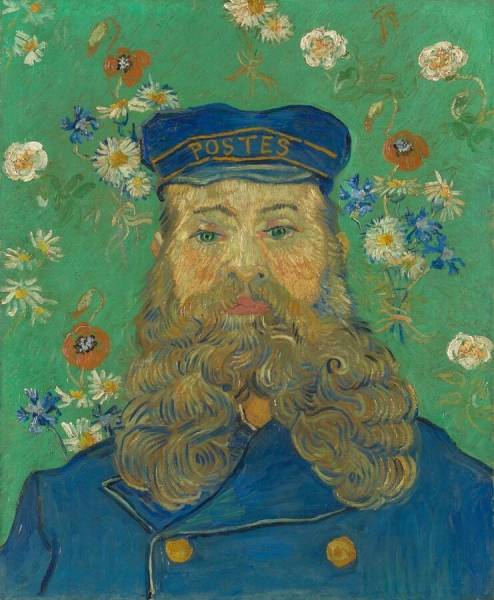
Portrait of Joseph Roulin
View Cadet CapsVincent van Gogh | 1889 | Oil on canvas | Museum of Modern Art, New York
In 1888, van Gogh moved to Arles in the South of France with the intention of starting an artist’s cooperative. There, he befriended Joseph Roulin and his family, became close, and painted them often. At this time, van Gogh, influenced by Paul Gaugin, was exploring “the modern portrait" - seeking to express the subject’s character via color and painting from intuitive memory rather than observation.
Here, van Gogh depicts Roulin, proud postal worker, in his uniform against a lush floral background. Roulin is wearing a cadet cap.
-
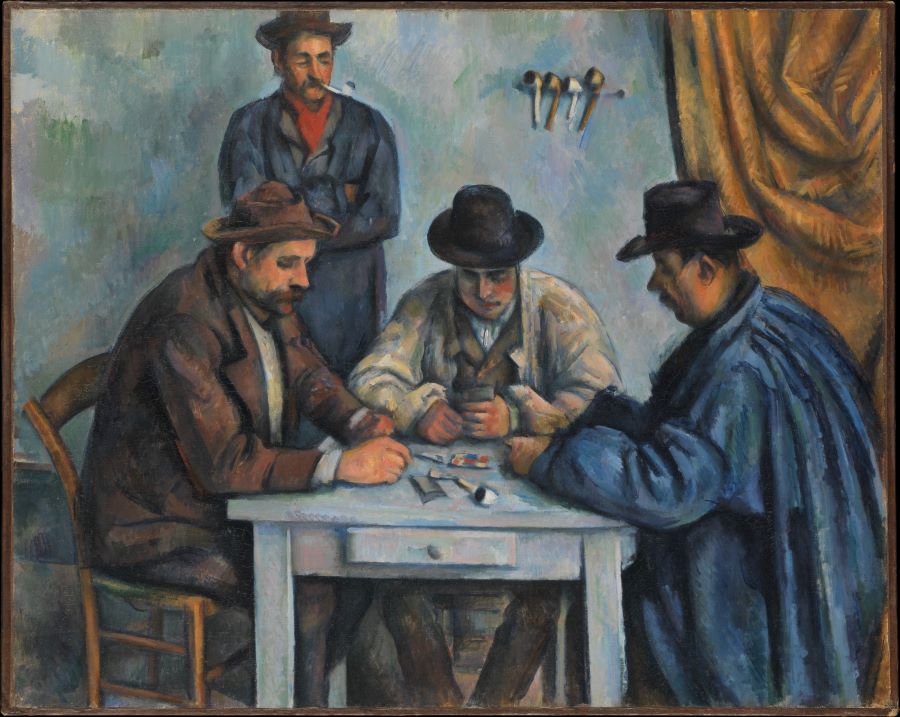
The Card Players
View our Selection of Men's HatsPaul Cézanne| 1890-92 | Oil on canvas | The Metropolitan Museum of Art, New York
One of the greatest Post-Impressionists, Cézanne is thought to have heavily influenced art movements that followed in the 20th century including Cubism and Fauvism. He is renowned for his ability to “build form” with color via contrast, thickly applied paint, and a darker palette. One of a series of five, this work is considered one of his finest figure compositions.
Four men are pictured - three playing cards and one observing. The men wear felt hats including a crumpled fedora (left), bowlers/derbys (center & standing), and a homburg/godfather (right).
-
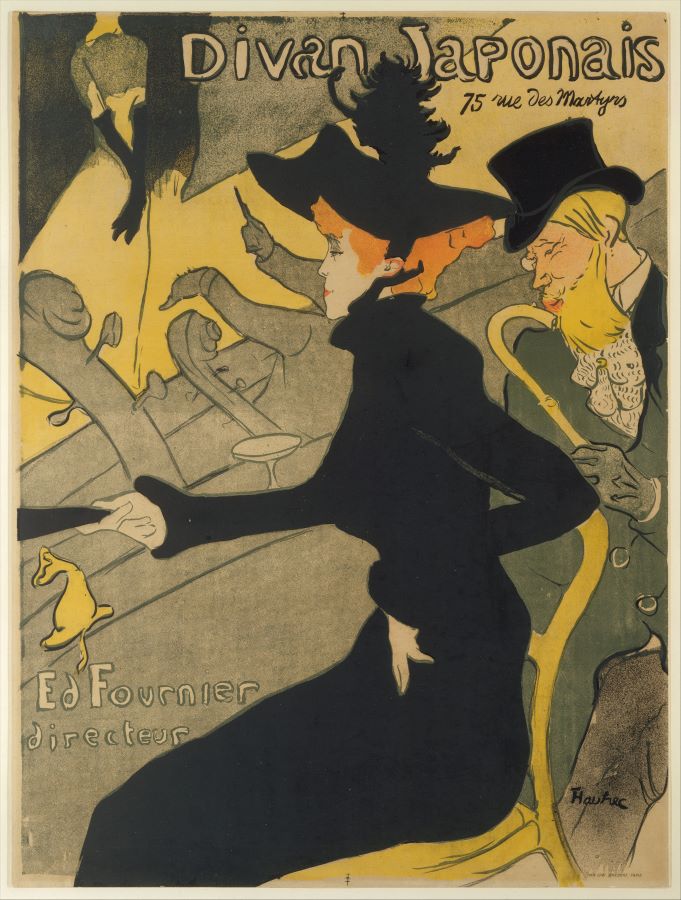
Divan Japonais
Henri de Toulouse-Lautrec | 1892-93 | Lithograph printed in four colors, wove paper | The Metropolitan Museum of Art, New York
Toulouse-Lautrec, a French aristocrat and artist, is infamous for his love of and depictions of the nascent nightlife of 1890s Paris. His brief career coincided with the development of modern printmaking, through which he elevated the humble lithograph advertisement medium to high art.
Here, Jane Avril and Édouard Dujardin are pictured at the Divan Japonais cabaret. Avril is wearing a dress hat similar to those designed by famed Parisian milliner Madame Virot, known to collaborate with well-known courtiers of the day.
-
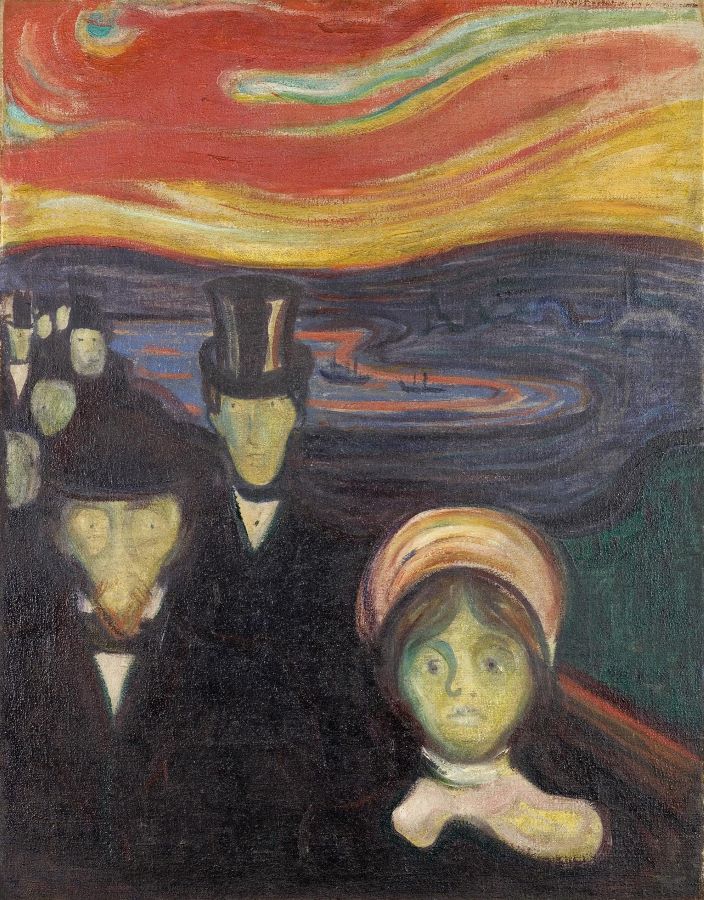
Anxiety
Edvard Munch | 1894 | Oil on canvas | The Munch Museum, Oslo
Munch is reknown for his psychologically charged and emotionally expressive art. Influenced by Naturalism, Gaugin, and van Gogh, Munch did not paint from observation: “I do not paint what I see, but what I saw.” Despite parallels to his most well-known work (Scream), Anxiety depicts collective despair and anxiety.
Anxiety also features clearly gendered subjects including a woman and group of men. Their garb includes felt top hats and bowler/derby hats for the men, and what appears to be a bonnet on the woman.
-

Jane Avril
Henri de Toulouse-Lautrec | 1899 | Color lithograph on tan wove paper | The Art Institute of Chicago, Chicago
This work by Toulouse-Lautrec similarly spotlights his favorite subject matter of Parisian nightlife. Jane Avril, a lifelong friend, is again featured but this time, she is performing rather than an observing. Known for her acrobatic and graceful dancing, she was regarded by many contemporaries as the “incarnation of dance.” This is on full display as she is pictured twisting, arms up in feigned surrender as an applique snake “slithers” up her lithe body.
Again, she is seen wearing a dramatic, Virot-like women’s dress hat adorned with large plumes.
-
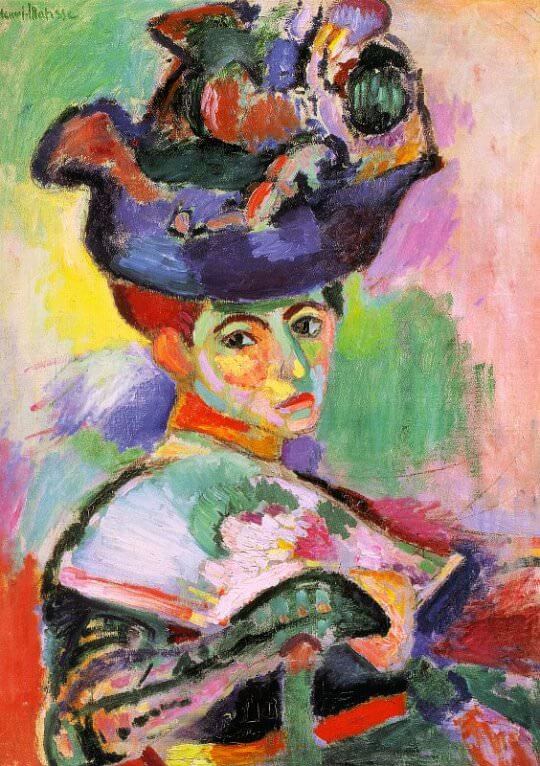
Woman with a Hat
Henri Matisse | 1905 | Oil on canvas | The San Francisco Museum of Modern Art, San Francisco
Matisse is one of the great masters of the early 20th century with a career spanning more than six decades consisting of painting, drawing, sculpture, graphic arts, and more. This work is largely credited with sparking the first avant-garde movement, Fauvism, (from the French “fauve” or “wild beast”) coined by a critic shocked by its seemingly arbitrary colors and frenetic brushwork.
This is a half-length portrait of the artist’s own wife, Amélie Matisse. She is pictured from the side in full bourgeois dress including gloves and an elaborate dress hat.
-

The Hat Makes the Man
View Women's Boater HatsMax Ernst | 1920 | Gouache, pencil, oil, and ink on cut-and-pasted printed paper on board | The Museum of Modern Art, New York
Ernst is most closely associated with Surrealism, an early 1900s movement which prized the unconscious and irrational over logic and reality. Techniques like frottage gave organic, singular results over which the artist had little control. Ernst is known to have said: “[I] came to assist as spectator at the birth of all my works.”
Here, Ernst painted over a women’s millinery (hat) catalog adding other cutouts to create treelike forms charged with innuendo. Included are women’s felt boaters and wide-brimmed hats.
-
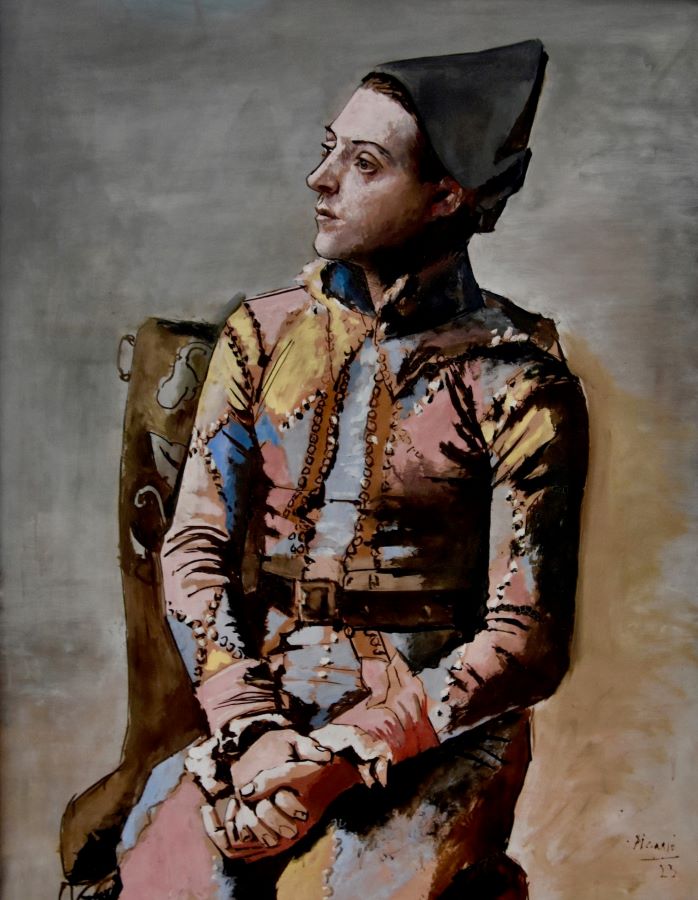
Seated Harlequin
Pablo Picasso | 1923 | Oil on canvas | Kunstmuseum Basel, Basel
Perhaps the most recognized artist by last name alone, Picasso is most famous for the co-creation of Cubism. He was, however, incredibly mutable and adaptable. His prolific career spanned over 80 years and included painting, drawings, sculptures, ceramics, and even poetry. He is largely considered the most influential artist of the 20th century.
This early work is of Catalan painter, Jacinto Salvadó, posing as a seated harlequin or jester. He is dressed in a colorful patchwork costume topped with a bicorn-shaped cap.
-
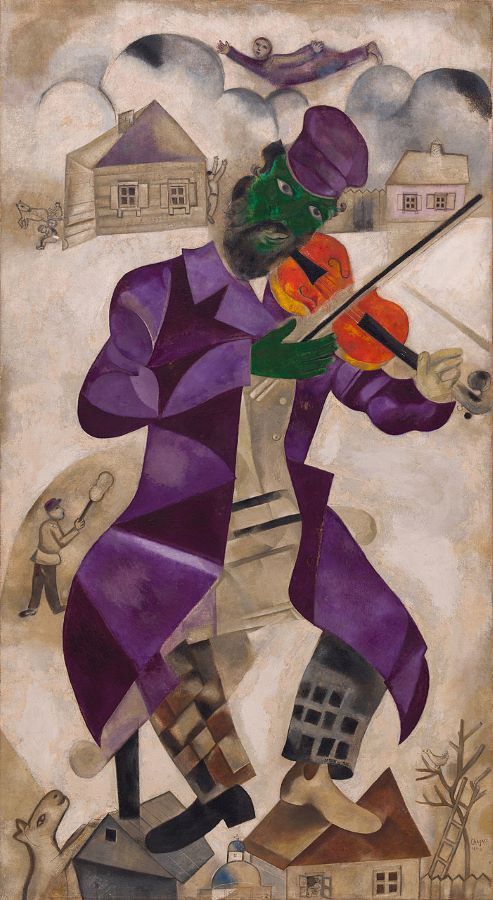
Green Violinist
Marc Chagall | 1923-24 | Oil on canvas | Solomon R. Guggenheim Museum, New York
Chagall’s work is uniquely his own and deeply imbued with his Jewish heritage and longing for his childhood home of Vitebsk in then Russia, now Belarus. His distinctive work borrowed elements from many avant-garde movements including Cubism, Fauvism, Surrealism, and others, but never fully "belonged" to one or the other.
This painting features a floating fiddler against a dreamlike scene. He is dressed in traditional Hasidic garb topped with a fiddler or Greek fisherman style cap.
-
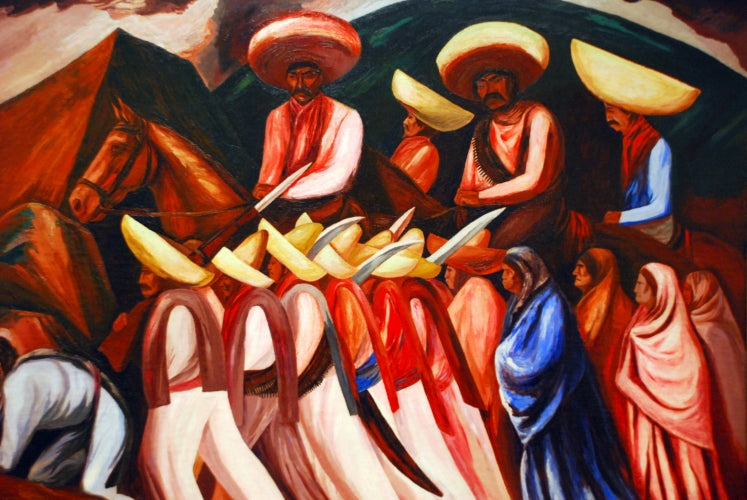
Zapatistas
Jose Clemente Orozco | 1931 | Oil on canvas | The Museum of Modern Art, New York
Orozco formed part of Los tres grandes or “Big Three” of leading muralists in early 20th century Mexico, together with Rivera and Siqueiros. His style - best described as Social Realism - focused on depicting the post-Revolutionary life and struggle of the common Mexican. This solemn scene depicts Zapatistas - followers of Mexican Revolutionary War leader Zapata - marching to their death. They are dressed in peasant garb including straw sombreros (men) and cloth mantillas or shawls (women).
-

Subway Portrait
View our Selection of Fedora HatsWalker Evans | 1938 | Gelatin silver print | National Gallery of Art, Washington, DC
Evans is the father of the American documentary photography tradition. His Subway Portrait series consisted of 89 covert photographs documenting New York City subway riders between 1938 - 1941 as they went about their day, guards completely down.
This family on the subway, like virtually anyone in those days, wear their fashionable hats as comfortably and naturally as they wear any other apparel. His classic fedora hat was de rigueur in the 1930s and 1940s.
-
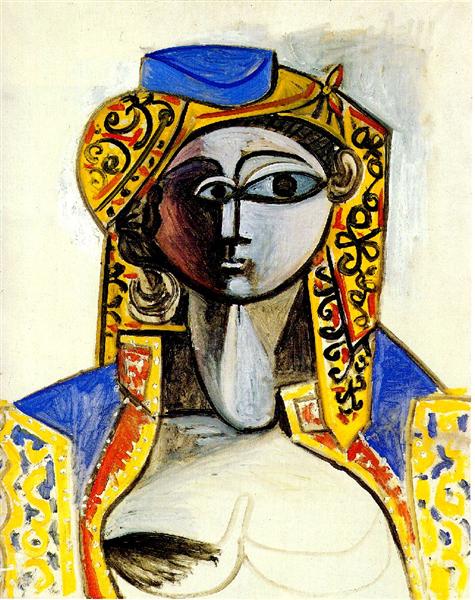
Jacqueline in Turkish Costume
View our Selection of Fez HatsPablo Picasso | 1955 | Oil on canvas | Private Collection
Picasso had many loves throughout his life that inspired his work. Jacqueline Roque was Picasso’s second wife and muse. For the last twenty years of Picasso’s life, Jacqueline provided steadfast support and inspiration, giving rise to his most prolific period. A constant presence throughout this period, Jacqueline’s likeness appears in over 200 portraits and imbued many of his other feminine depictions.
Here she is pictured in Turkish garb complete with veil and a stylized fez hat.
-
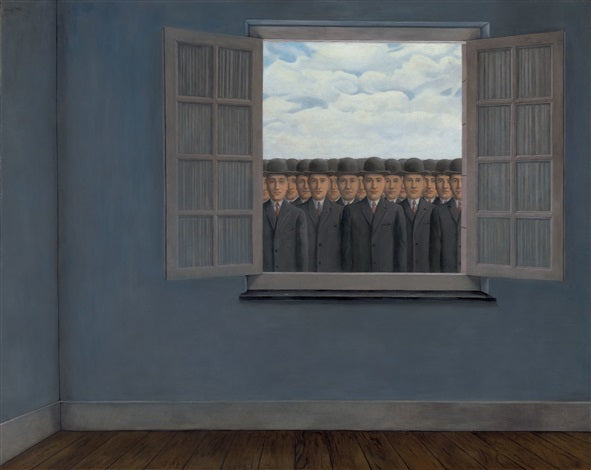
The Month of the Grape Harvest
View Bowler & Derby HatsRene Magritte | 1959 |Oil on canvas | Private Collection
Magritte, a well-known Surrealist, sought to “challenge the real world” by depicting ordinary objects and subjects in ways that challenged perception. The bowler or derby hats the men are wearing here was created in 1850. Books have been written (literally) about the symbolic significance of this apparel item and its relationship to the Modern Age.
Magritte is not alone in using the bowler/derby as an icon in art, theater, or literature. For more on this read The Man in the Bolwer Hat: His History and Iconography by Fred Miller Robinson.

































